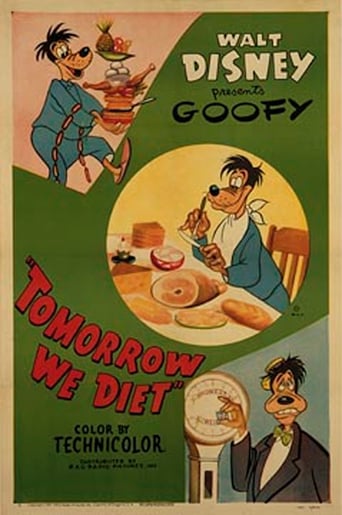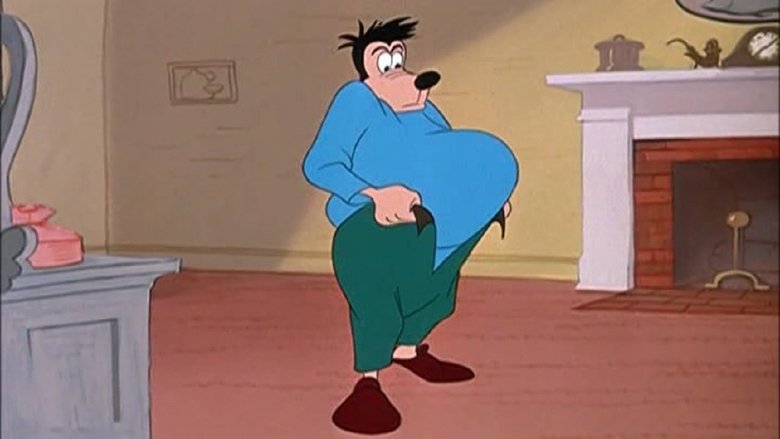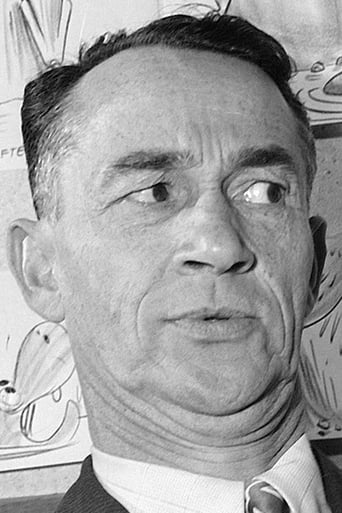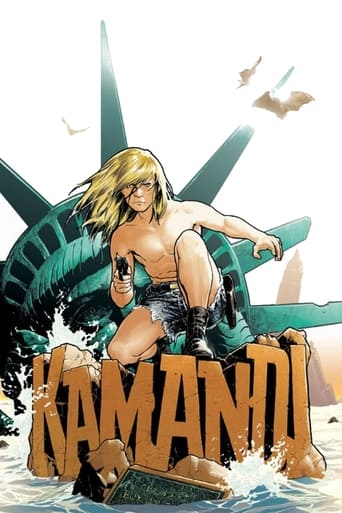

Tomorrow We Diet (1951)
Indeed, man craves to eat and George Geef (Goofy) is no exception. He eats like it's going out of style. Finally, his reflection in the mirror tells him he's getting too fat. Goofy starts showing all the signs of being overweight. When he gets into a taxi, the back tires deflate. When he gets into an elevator, the elevator remains grounded. Goofy's reflection "helps" him lose weight by refusing to let him eat. Geef thinks he can resist but is soon upset by all manner of temptations. He goes to bed but sleepwalks to the refrigerator only to discover it is empty. It turns out his reflection ate all the food telling him, "Eat, drink, and be merry, and tomorrow we diet!"
Watch Trailer
Cast


Similar titles
Reviews
This cartoon had a very negative view on how I felt about cellulite. As a child, I struggled when I heard the word fat, feeling like there was nothing good about it.From the age of 5 till about 10, I had seen quite a few things about weight portrayed in a horrible light. This cartoon did not help that image.There were several scenes from this short that stuck with me. Goofy deflating the car tires, grounding the elevator, and his stomach growling like a dog. He tightens his belt to suppress his hunger, only to watch in horror as it busts lose, his gut now whimpering like a frightened pup.The harshest thing about this was the fact that Goofy's reflection talked negatively to him instead of giving him encouragement. I believe this may well be Goofy's conscious telling him to improve his lifestyle. However, it doesn't seem to work very well and at the end of the cartoon. Goofy's reflection has now eaten all the food. So if this is indeed Goof's conscious, he has taken a turn for the worse and will continue his gluttonous ways.This cartoon would probably be more funny to me now than a while back. Some of the scenes are just overblown. I will come back later to clean up my review and give a final score for this.
Goofy seems to have a lot of these stories where the plot in his cartoons are experimental. In this case, Goofy, identified as a character named George Geef, goes through overweight challenges, as highlighted in a somewhat hilarious way in this cartoon (which would not be very PC nowadays).This cartoon is more like a mini-documentary than an animated story. Not much laughs in this one and Goofy does not speak in his iconic voice. It's not an awful cartoon, just a little mediocre.Grade C+
Goofy opens up the cartoon by eating a whole table of food in a few seconds. His reflection tells him he's too fat and he gets new clothes. When he gets in the taxi, the tires deflate, the elevator won't go up, and he falls off his chair. His reflection tells him not to eat, but he reads a book with food, tempting to eat even more. The EAT, EAT, EAT, repeatedly is pretty scary at first. Goofy goes to bed but he wakes up wanting to eat, but his reflection ate all the food in the fridge.I only like Goofy shorts from Disney, I never watch Mickey or his other friends, they just aren't that funny as the Warner Bros. characters.10/10
A Walt Disney GOOFY Cartoon.The difficulties with weight gain and dieting are humorously depicted.Millions of viewers will sympathize with the Goof as he attempts to remove several pounds of avoirdupois and refrain from eating the goodies in the refrigerator. Clever usage is made of eight actual pages - not animated - from a Betty Crocker-like cookbook from the era.Walt Disney (1901-1966) was always intrigued by pictures & drawings. As a lad in Marceline, Missouri, he sketched farm animals on scraps of paper; later, as an ambulance driver in France during the First World War, he drew comic figures on the sides of his vehicle. Back in Kansas City, along with artist Ub Iwerks, Walt developed a primitive animation studio that provided animated commercials and tiny cartoons for the local movie theaters. Always the innovator, his ALICE IN CARTOONLAND series broke ground in placing a live figure in a cartoon universe. Business reversals sent Disney & Iwerks to Hollywood in 1923, where Walt's older brother Roy became his lifelong business manager & counselor. When a mildly successful series with Oswald The Lucky Rabbit was snatched away by the distributor, the character of Mickey Mouse sprung into Walt's imagination, ensuring Disney's immortality. The happy arrival of sound technology made Mickey's screen debut, STEAMBOAT WILLIE (1928), a tremendous audience success with its use of synchronized music. The SILLY SYMPHONIES soon appeared, and Walt's growing crew of marvelously talented animators were quickly conquering new territory with full color, illusions of depth and radical advancements in personality development, an arena in which Walt's genius was unbeatable. Mickey's feisty, naughty behavior had captured millions of fans, but he was soon to be joined by other animated companions: temperamental Donald Duck, intellectually-challenged Goofy and energetic Pluto. All this was in preparation for Walt's grandest dream - feature length animated films. Against a blizzard of doomsayers, Walt persevered and over the next decades delighted children of all ages with the adventures of Snow White, Pinocchio, Dumbo, Bambi & Peter Pan. Walt never forgot that his fortunes were all started by a mouse, or that childlike simplicity of message and lots of hard work always pay off.




